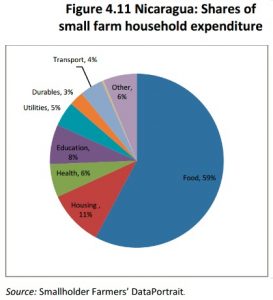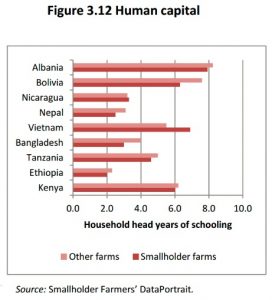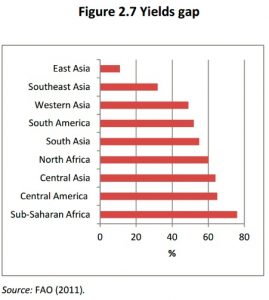Titus Kabega and I were interested in the social and financial side of agriculture in rural Nicaragua, and we wanted to see if there was any way we could come up with to improve the lives of farmers working in villages like Tadasna, which we are visiting in December. Many farmers in the region work for subsistence rather than profit, which motivated us to model the costs and benefits of farming different crops and different uses for them.
Pulling data from many different websites and organizations, we compiled these charts:
| Crop | Yield (per year per Ha) | Calories (per kg) | Calories (per year per Ha) | Protein | ||
| Rice (paddy) | 4,052.6 Kg1 | 1,298 Calories5 | 5,260,000 Calories | 8%5 | ||
| Beans | 773.9 Kg1 | 3,412 Calories5 | 2,641,000 Calories | 22%5 | ||
| Cocoa | 307.7 Kg1 | 2,279 Calories5 | 701,000 Calories | 16%5 | ||
| Chicken (for meat) | 173.6 Kg | 2,160 Calories5 | 375,000 Calories | 34%5 | ||
| Chicken (for eggs) | 350.4 Kg | 1,428 Calories5 | 500,000 Calories | 35%5 |
| Crop | Yield (per year per Ha) | Calories (per kg) | Calories (per year per Ha) | Protein | ||
| Rice (paddy) | 4,052.6 Kg1 | 1,298 Calories5 | 5,260,000 Calories | 8%5 | ||
| Beans | 773.9 Kg1 | 3,412 Calories5 | 2,641,000 Calories | 22%5 | ||
| Cocoa | 307.7 Kg1 | 2,279 Calories5 | 701,000 Calories | 16%5 | ||
| Chicken (for meat) | 173.6 Kg | 2,160 Calories5 | 375,000 Calories | 34%5 | ||
| Chicken (for eggs) | 350.4 Kg | 1,428 Calories5 | 500,000 Calories | 35%5 |
If these charts are correct, they indicate that rice and beans, which are primarily what the farmers currently grow, are best for consumption, while cocoa is best for sale. However, we ran into some literature that indicates farmers are wary to devote some of their land to Cocoa because, should their subsistence crops have a bad year, their families would starve. That got us interested in exploring different social and community models that would allow farmers to devote more land to cash crops, which would give them more access to other resources such as education and health services that they currently lack, while also offering a safeguard to starvation should crops fail.
Our research found additional challenges that rural Nicaraguan farmers face
Lack of access to credit: High percentage cost of food:
Lack of access to education: Crop yield gap:
These, among other issues, evidence the advantages that growing less time intensive, higher cost yielding crops could provide to rural farmers. We revised a model from a cooperative currently operating in rural Nicaragua to make it more attractive to farmers. To the current cooperative model, which currently is primarily intended to give farmers more bargaining power when they sell their crops combined in bulk, we suggest adding a technology research component, more access to economies of scale, offering a line of credit, lowering the minimum acreage requirement, and offering insurance should the farmer have a bad season.
While we do think that our cooperative model would improve the lives of farmers, we have no way of confirming this until we travel to Nicaragua and get a feel for the attitudes and motivations of subsistence farmers in areas such as Tadasna. We want to avoid at all costs telling them what to do, especially since we are not experts and only have a small grasp on what their lives are like. We primarily want to offer and feel out some ideas we have, which will be our primary focus when we interact with farmers and residents while Titus, who is also on the CD team, and I are in Nicaragua.
For access to our full presentation, please email me at eric.j.greenlee.18@dartmouth.edu
Sources for our presentation:
http://faostat.fao.org/beta/en/#data/QC
https://www.numbeo.com/food-prices/country_result.jsp?country=Nicaragua
http://www.Nutritiondata.self.com
http://www.weedemandreap.com/raise-meat-chickens-part1/https://www.reference.com/pets-animals/
http://www.housetohomestead.com/2011/03/chicken-math-how-much-meat-is-in-a-whole-chicken/
http://articles.extension.org/pages/71004/raising-chickens-for-egg-production
http://www.fews.net/sites/default/files/documents/reports/Nicaragua_2015_02_PB_EN.pdf
https://www.numbeo.com/cost-of-living/in/Managua
http://www.worldbank.org/en/news/feature/2014/05/06/chocolate-nicaragua
https://www.theguardian.com/global-development-professionals-network/2014/sep/11/monoculture-is-failing-nicaraguas-farmers
http://southeastfarmpress.com/grains/florida-study-shows-rice-grown-without-paddies-can-feed-drought-stricken-communities
http://www.caltnica.org/projects
http://www.wikiwand.com/en/Siuna,_Nicaragua
http://www.fao.org/docrep/x5427e/x5427e0i.htm
http://www.fao.org/3/a-i5251e.pdf
https://www.ifad.org/documents/10180/7770b19f-53d7-4ef6-8326-e931c40d356b




